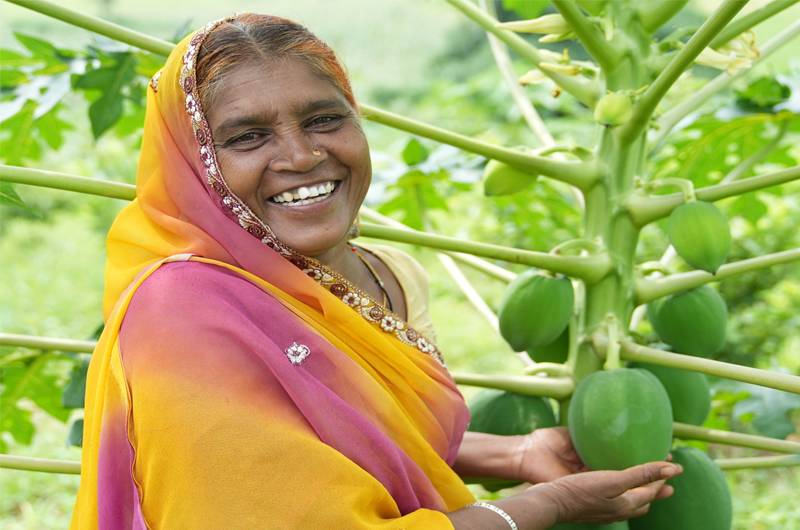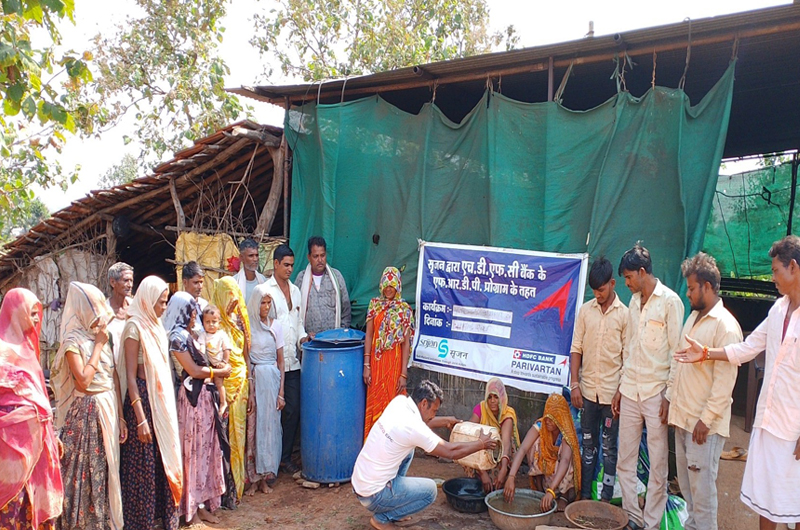Till four years ago, the future looked bleak for the Meena households in Kalyanpura Village of Suhagpura Block, Pratapgarh District, a part of Rajasthan with high levels of multi-dimensional poverty. As expenses increased but yields remained stagnant, migration grew. It was at this stage that a voluntary organisation entered the scene and encouraged women to form producer groups and follow natural farming practices, backed by the HDFC Parivartan Project. Bharat Dogra reports
Ezan, a woman from the Meena Adivasi Community, is tired yet happy. “I have been working very hard in my new orchard, as I must make a success of this. But I am much more enthusiastic about this than before, as a lot has been happening in our village in recent times, which gives us hope for the future,” she says.
Till four years ago, the future looked bleak for the Meena households in Kalyanpura Village of Suhagpura Block, Pratapgarh District, a part of Rajasthan with high levels of multi-dimensional poverty. As expenses increased but yields remained stagnant, migration grew. It was at this stage that SRIJAN (Self Reliant Initiatives through Joint Action) a voluntary organisation, entered the scene and encouraged women to form producer groups. The HDFC Parivartan Project, which took forward an existing scheme to improve nutrition and sustainable livelihoods while protecting the environment, helped households create multi-layer vegetable gardens and fruit orchards (with the focus on guava) on a part of their lands.

What is more, natural farming methods were employed and vermin-compost was made, as a result of which the produce was healthy, soil health improved and farmers’ expenses reduced. Kitchen gardens have also contributed to increased availability of vegetables, mostly for self-consumption but in some cases also for sale. Women like Laxmibai are particularly happy as they are now able to include many more vegetables in family meals, leading to better health. Natural farming practices were successfully promoted in orchards, vegetable and kitchen gardens and farmers are now confident of introducing this on their agricultural lands as well, raising hopes of the village gradually shifting to natural farming.
In Semaliya Khurd Village of the same block, farmer Amba Lal explained that the response to the spread of natural farming has on the whole been positive, despite the difficulties encountered in the early stages, and farmers are pacing the change over a number of years. In due course, Amba Lal says, speaking from experience, the situation stabilises and the yield becomes good, and expenses less. There was some initial hesitation regarding the focus on guava orchards too, but after group discussions, it was decided that inter-cropping was viable, ensuring that a significant amount of the staple food crop continues to be available.
One encouraging aspect of recent mobilisation efforts is that as villagers, particularly women, are meeting for discussions more frequently, solutions to various problems are emerging. In Semaliya Khurd, the erratic supply of electricity was a big problem for irrigation. SRIJAN offered to help provide solar pumping sets, with farmers contributing a part of the expenses. However, though they were enthused by the suggestion, many farmers did not have the resources to meet the financial commitment even partly. But a solution emerged after dialogues – several farmers now have pump sets to meet their own irrigation needs and provide water to others for a reasonable charge, thus recovering a part of their investment. Perhaps arranging such irrigation modes at the community level will help reduce farmers’ expenses.

representative from HDFC Bank demonstrating the use of vermin-compost to women who are part of producer groups, as villagers look on.
Such efforts have spread and nearly 140,000 fruit trees have been planted under this project during the past three years in over 50 villages of Suhagpura Block. Several senior officials have commended the work and extended help and encouragement, while also obtaining the cooperation of SRIJAN in their own work, like in the recent distribution of about 500 vegetable seed kits. This bodes well for the further strengthening of this project. As SRIJAN’s team leader Premnath Yogi explains, one of the important future areas of focus is for women producer groups (like Dhan Laxmi in Kalyanpura) to get together and set up a company of farmers, named Dolmashree, which can take up value-addition and processing activities like extracting mahua oil so that households do not have to pay others for this, while they also get better quality oil and save the oilcake as well.
However, there are constraints, particularly relating to the scarcity of water in many villages. Even as many women who I talked to at two group discussions recently were enthusiastic about their guava orchards, a shadow would invariably appear on their faces when they talked about the difficulties of arranging adequate irrigation during the months of water scarcity. Hence, facilitating irrigation based on existing water sources is not sufficient – what is important is to increase water sources and improve their capacities. As senior SRIJAN representative Mohd Saquib says, water availability is perhaps the most important factor in the realisation of several development objectives here and should get the highest priority.
(The writer is a senior freelance journalist and author who has been associated with several social movements and initiatives. He lives in New Delhi.)



 from Webdoux
from Webdoux